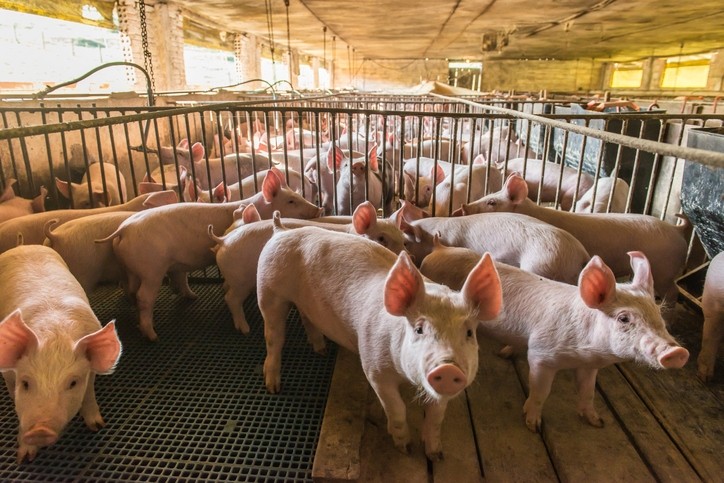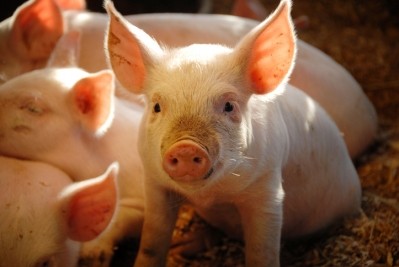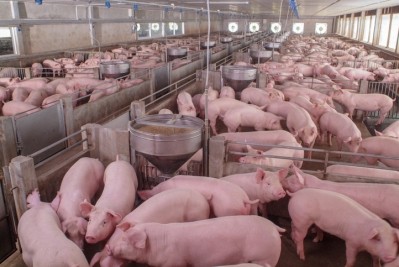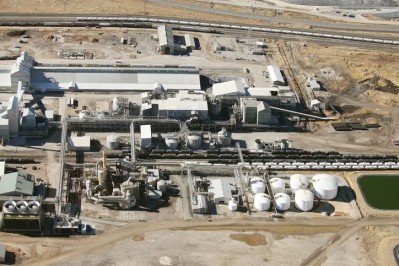Feed acidification would appear not to increase phytase efficacy

The team, writing in Livestock Science, documented how the incorporation of phytase in pig feed improved bone mineralization, while adding formic acid to the ration improved growth, FCR and the apparent total tract digestibility (ATTD) of magnesium, iron and calcium.
However, even though the formic acid addition reduced stomach pH, no interaction between phytase efficacy and acidification was seen, found the researchers.
Hypothesis for research
Phosphorus (P) from plant sources in pig diets occurs primarily in the form of phytate, and the pig has a limited ability to degrade phytate. To reduce the amount of P in feces and hence environmental pollution, exogenous phytase is routinely added to pig diets. However, phytase does not degrade the phytate completely.
The authors said that many minerals like calcium (Ca), zinc (Zn), iron (Fe), copper (Cu) and magnesium (Mg) are bound to phytate in mineral-phytate complexes. This reduces the phytate degradation, thus decreasing both mineral digestibility and phytate-P availability (Maenz et al., 1999).
The effect of phytase addition on mineral digestibility is not consistent, they noted. Arredondo et al. (2019) found an increased apparent total tract digestibility (ATTD) of Mg and Zn with phytase addition, but no improvement in ATTD of Cu, Fe and Mn.
The affinity of the minerals to phytate is dependent on pH level, and organic acids are expected to increase mineral absorption by lowering stomach pH and reducing the binding of these minerals to phytate in addition to the increased phytase efficacy by lowered pH (Jongbloed et al., 2000), said the Norwegian team.
Several experiments have shown that organic acids have a positive effect on phytase efficacy (Kemme et al., 1999; Jongbloed et al., 2000). However, other experiments have shown no interaction between organic acid and phytase (Radcliffe et al., 1998; Omogbenigun et al., 2003), they noted.
As organic acid is routinely added to piglet feed and conflicting results on the effect on phytase efficacy have been reported, they wanted to investigate the effect of phytase, acid addition and their interaction effects.
“The hypothesis that acidification of the feed in combination with addition of microbial phytase will increase phytase efficacy was tested. In addition, the effect on other phytate-bound minerals was examined.”
Methodology
An experiment was carried out to assess the effect of reduced feed pH and addition of phytase and their interactions on performance, mineral retention (Ca, P, Mg, Zn, Fe and Cu) and bone mineralization.
A wheat-based diet with a high phytate-P content and no inorganic phosphorus added, or the same diet with either 1.4 % formic acid, 500 FTU C. braakii-derived phytase or both added, were used.
The feed was produced in two batches in a commercial feed plant (Felleskjøpet Rogaland Agder, Stavanger, Norway) with raw materials from the same batch to lessen the variation in raw material quality and containing 5.0 g/kg titanium dioxide (TiO2) as a digestibility marker.
The feed was pelleted with a minimum heat treatment of 81 degrees Celsius during production.
Thirty-two piglets, with a mean weight of 21.06 ± 0.83 kg were distributed in eight pens. Individual feed intake was recorded, and all treatments were represented in all pens. The experimental period was 28 days.
Performance was recorded, pH in stomach, jejunum and ileum was measured and content from jejunum and ileum was collected for assessment of P digestibility. In addition, feces were collected for total digestibility measurements and left third and fourth metacarpal were analyzed for bone mineralization.
Key findings
No interaction effects between phytase and acid addition were found.
Phytase addition increased growth, jejunal P digestibility, total tract digestibility of phosphorus and calcium and bone mineralization, said the researchers.
Acid addition improved growth and FCR in addition to total tract digestibility of magnesium, iron and calcium.
“The experiment confirmed that phytase addition improved P digestibility. However, no increased phytase efficacy was seen with acid addition. There was no interaction effect between phytase and pH reduction in the stomach.”
Source: Livestock Science
Title: The effect of reduced feed pH, phytase addition and their interaction on mineral utilization in pigs
Authors: S. Kristoffersen, T Gjefsen, B. Svihus, N. Petter Kjos















